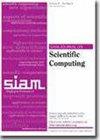Energetic Variational Neural Network Discretizations of Gradient Flows
IF 2.6
2区 数学
Q1 MATHEMATICS, APPLIED
引用次数: 0
Abstract
SIAM Journal on Scientific Computing, Volume 46, Issue 4, Page A2528-A2556, August 2024.Abstract. We present a structure-preserving Eulerian algorithm for solving [math]-gradient flows and a structure-preserving Lagrangian algorithm for solving generalized diffusions. Both algorithms employ neural networks as tools for spatial discretization. Unlike most existing methods that construct numerical discretizations based on the strong or weak form of the underlying PDE, the proposed schemes are constructed based on the energy-dissipation law directly. This guarantees the monotonic decay of the system’s free energy, which avoids unphysical states of solutions and is crucial for the long-term stability of numerical computations. To address challenges arising from nonlinear neural network discretization, we perform temporal discretizations on these variational systems before spatial discretizations. This approach is computationally memory-efficient when implementing neural network-based algorithms. The proposed neural network-based schemes are mesh-free, allowing us to solve gradient flows in high dimensions. Various numerical experiments are presented to demonstrate the accuracy and energy stability of the proposed numerical schemes.
梯度流的能量变异神经网络离散化
SIAM 科学计算期刊》,第 46 卷第 4 期,第 A2528-A2556 页,2024 年 8 月。 摘要。我们提出了一种求解[数学]梯度流的结构保留欧拉算法和一种求解广义扩散的结构保留拉格朗日算法。这两种算法都采用神经网络作为空间离散化工具。与大多数根据底层 PDE 的强或弱形式构建数值离散的现有方法不同,所提出的方案是直接根据能量消耗定律构建的。这保证了系统自由能的单调衰减,避免了解的非物理状态,对数值计算的长期稳定性至关重要。为了应对非线性神经网络离散化带来的挑战,我们在空间离散化之前对这些变分系统进行了时间离散化。在实施基于神经网络的算法时,这种方法具有计算记忆效率。所提出的基于神经网络的方案是无网格的,使我们能够解决高维度的梯度流问题。各种数值实验证明了所提数值方案的准确性和能量稳定性。
本文章由计算机程序翻译,如有差异,请以英文原文为准。
求助全文
约1分钟内获得全文
求助全文
来源期刊
CiteScore
5.50
自引率
3.20%
发文量
209
审稿时长
1 months
期刊介绍:
The purpose of SIAM Journal on Scientific Computing (SISC) is to advance computational methods for solving scientific and engineering problems.
SISC papers are classified into three categories:
1. Methods and Algorithms for Scientific Computing: Papers in this category may include theoretical analysis, provided that the relevance to applications in science and engineering is demonstrated. They should contain meaningful computational results and theoretical results or strong heuristics supporting the performance of new algorithms.
2. Computational Methods in Science and Engineering: Papers in this section will typically describe novel methodologies for solving a specific problem in computational science or engineering. They should contain enough information about the application to orient other computational scientists but should omit details of interest mainly to the applications specialist.
3. Software and High-Performance Computing: Papers in this category should concern the novel design and development of computational methods and high-quality software, parallel algorithms, high-performance computing issues, new architectures, data analysis, or visualization. The primary focus should be on computational methods that have potentially large impact for an important class of scientific or engineering problems.

 求助内容:
求助内容: 应助结果提醒方式:
应助结果提醒方式:


